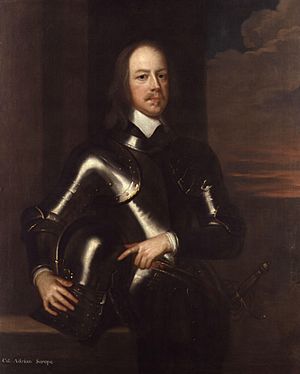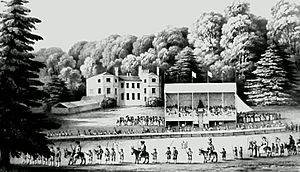Adrian Scrope facts for kids
Quick facts for kids
Adrian Scrope
|
|
|---|---|

Adrian Scrope by John Faber the Younger, circa 1719
|
|
| Council of Scotland | |
| In office 1655–1658 |
|
| Governor of Bristol Castle | |
| In office 1649–1655 |
|
| Personal details | |
| Born | 12 January 1601 Wormsley Park, Buckinghamshire |
| Died | 17 October 1660 (aged 59) Charing Cross, London |
| Nationality | English |
| Political party | Parliamentarian |
| Spouse | Mary Waller (married 1624) |
| Children | 5 |
| Alma mater | Hart Hall, Oxford |
| Occupation | Soldier and administrator |
| Military service | |
| Allegiance | Parliamentarian Commonwealth |
| Years of service | 1642–1649 |
| Rank | Colonel |
| Battles/wars | |
Adrian Scrope (born 12 January 1601, died 17 October 1660) was an English soldier and politician. He was known as a Parliamentarian, meaning he supported the Parliament against King Charles I during the Wars of the Three Kingdoms. Scrope was one of the people who signed the document ordering the execution of King Charles I in 1649.
After the king's son, Charles II, became king in 1660, Scrope was arrested. Even though he was first promised he would be safe, he was later found guilty of treason and executed in October 1660.
Scrope was a rich landowner from Buckinghamshire. He was also related to John Hampden, another important Parliamentarian leader. He fought in both the First and Second English Civil Wars. Oliver Cromwell, a powerful leader of the Parliamentarian army, put Scrope in charge of security during the trial of King Charles I. Scrope was there every day of the trial and signed the king's death warrant.
Contents
Adrian Scrope's Early Life and Family
Adrian Scrope was born at Wormsley Park in Buckinghamshire. He was baptised on 12 January 1601. His parents were Sir Robert Scrope and Margaret Cornwall. His family was a branch of the important Scropes of Bolton family.
In 1624, Adrian Scrope married Mary Waller. She was the sister of Edmund Waller, a famous poet who supported the King. Adrian and Mary had at least eight children. Their youngest daughter, Elizabeth, married Jonathan Blagrave. He was related to another person who signed the king's death warrant, Daniel Blagrave. Elizabeth Scrope's memorial can still be seen in St Mary's Collegiate Church, Youghal. It mentions her father, Colonel Adrian Scrope.
Adrian Scrope's Military Career
Adrian Scrope studied at Hart Hall, Oxford and then law at the Middle Temple. We don't know much about his life before the First English Civil War started in 1642. Because he was related to John Hampden, he joined the Parliament's army. He led a group of cavalry (soldiers on horseback) for the Earl of Essex and fought in the Battle of Edgehill.
Fighting in Key Battles
In 1644, Scrope joined Sir Robert Pye's cavalry regiment. He fought in important battles like Lostwithiel and the Second Battle of Newbury. In 1645, he moved to the New Model Army, which was Parliament's main army. He became a major. His regiment fought in the South-Western campaign, including battles at Langport and the Bristol.
Escorting the King
In 1646, King Charles I escaped from Oxford and joined the Scottish army. In March 1647, the Scots handed the king over to the English Parliament. Scrope's regiment helped escort the king to Holdenby House. Later, Scrope became a colonel and took charge of the king's guard.
Ending Rebellions
In 1648, Scrope helped put down a rebellion in Kent and Essex. He also stopped another uprising in Cambridgeshire. On 10 July, he captured Henry Rich, 1st Earl of Holland at the Battle of St Neots.
Role in the King's Trial
Before the Second Civil War ended, Scrope was sent to Great Yarmouth because there were rumors that the Prince of Wales (who would later become Charles II) was trying to land there. Around this time, Oliver Cromwell may have suggested that King Charles I should be put on trial and executed. Scrope became a member of the Army Council and supported the removal of members of Parliament who disagreed with the army. He was chosen as one of the judges for the trial of King Charles I and voted for his execution on 30 January 1649.
Later Military Roles
In April 1649, some soldiers in the army rebelled. Scrope's regiment, based in Salisbury, refused to go to Ireland. Only eighty men stayed loyal to Scrope. The rebellion was stopped by Cromwell and Fairfax, and Scrope's regiment was disbanded.
After this, Scrope's active military career ended. In October 1649, he became the governor of Bristol Castle. He held this job until June 1655, when the castle was torn down. In August 1655, he was appointed to the new Council of Scotland. This group was set up by Cromwell to govern Scotland after it became part of the Commonwealth.
Adrian Scrope's Execution
Adrian Scrope did not play a big part in the political changes that led to Charles II becoming king in May 1660. When Charles II ordered that all those who signed his father's death warrant must surrender, Scrope obeyed. At first, it seemed he would only have to pay a fine.
However, things changed. An important Member of Parliament, Sir Richard Browne, claimed that Scrope had refused to say that the execution of Charles I was wrong. Because of this, Parliament decided that Scrope should be put on trial.
At his trial on 12 October, Scrope said he had only followed Parliament's orders. He admitted he had made a "mistake in judgment." The judge, Sir Orlando Bridgeman, agreed that Scrope was "not such a person as some of the rest." However, because of Browne's evidence, Scrope was found guilty and sentenced to death.
On 17 October 1660, Adrian Scrope was executed at Charing Cross in London. He was executed along with Thomas Scot, Gregory Clement, and John Jones Maesygarnedd. As a special favor, his body was given back to his family for burial, instead of being put on display.
See Also


